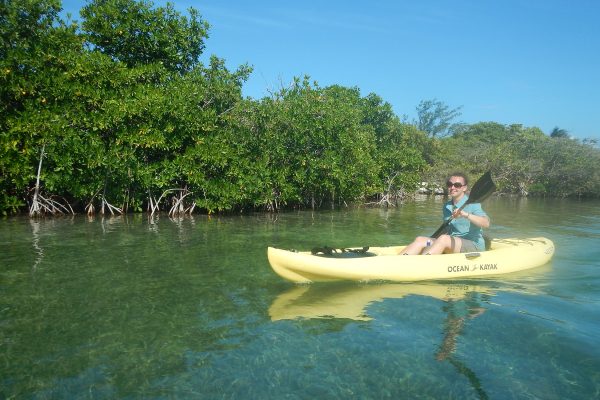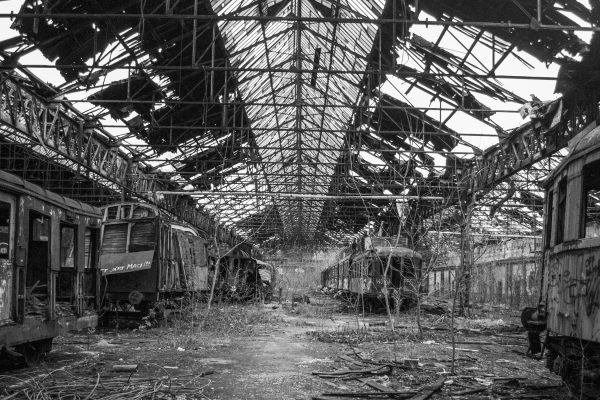Trip duration: 10 days | Approx cost: £800 for a 10 day tour (exc flights) | When: November
Doinit factor: It’s Somalia! – well kind of!
Long ostracized by the majority or the World, Somalia has been in a state of anarchy since the 1991 Civil War that killed between 350,000 and 1, 000,000 Somali’s. The War played host to one of the most famous US military failures, ‘Black Hawk Down’ and a power vacuum following the ousting of Siad Barre has created what many consider the World Most Dangerous State. From disarray, a glimpse of hope and democracy has spoorned in the north of the country where the state of Somaliland has declared independence and attempts to distance itself from the violence
Arriving in Addis Ababa
Day one
I land in the early hours of the morning at Addis International Airport in Ethiopia. Having secured my visa in London prior to arrival, there’s no need to go through the bureaucracy at the airport and I am pleasantly surprised at the speed I progress through immigration and baggage collection. On arrival I’m greeted by the familiar fixers of Africa trying to get you in there unlicensed taxi, arrange accommodation or exchange money so I make headway and search my transfer to the hotel. A fruitless search, and with my mobile not working, I spring up a conversation with one of the hotel porters outside who is waiting for his own guests to arrive and he kindly offers to call my hotel. I’m assured to wait there and it will arrive. 30minutes later I’m unconvinced and head back to the airport terminal and another porter offers to make the call. Success. I make my way directly outside and a minibus rocks up with the hotel name on it. A short 20minute transfer and I make up for the sleep I’ve missed out on with a morning nap.
Midday I arise and as I look over my trips itinerary I decided to see if I can explore the part of Addis Adaba that I’m not due to see. The hotel arranges for a taxi to take me the 9.5km to the Mercato (350birr or £9) so I can be thrown out of my comfort zone without a moment to lose. The market is truly massive. The World’s largest open air market to be precise. Here you can get anything your heart desires – from food, to second, third, and fourth hand underwear. You just need to find it! I wander around aimlessly taking in the atmosphere and feeling deeply out of my comport zone. I had been Africa and various similar destinations before but never had I been the sole Western tourist, swallowed up by locals. I’m conscious I stick out like a sore thumb and with no other tourists for moral support, I don’t risk taking out my camera. I’d been warned not to eat any of the street foods on offer but it looks and looks delicious. After several hours of wandering I decide to make my way back to the hotel via a coffee house, restaurant and some souvenir shops along Churchill Avenue. I don’t fancy the 9.5km walk back so I jump on the new Tramway built by the Chinese and with GoogleMaps and the help of GPS, I estimate where I need to jump out.

Above: The worlds largest open-air market in Addis Ababa – though it can feel a tad enclosed
Getting up close and personal with Lucy
Day two
Breakfast the next day and it’s a chance to meet with our tour guide and the rest of the group. We exchange pleasantries and James, our tour guide briefs us on the day’s activity. Scanning the group, it’s a truly international and multicultural affair; Americans, Chinese and Libyans all as curious as myself to explore this untamed land.
The first stop of the day is the Ethiopian National Museum which is home to some of the oldest known remains of both humans and animals, including the World famous ‘Lucy’ – the first of a dozen ancient humanoids discovered. The short tour with a guide around the museum includes explanations and demonstrations of how evolution has taken its path throughout the centuries and we are shown artifacts dating back to the time of Ethiopia’s great Emperor, Hallie Selasie. Whilst the Lucy skeleton only consists of around 40% of the actual bones, there is a striking resemblance with the human anatomy. I stand there looking at the remains wondering what the ‘human’ could have possibly looked like over 3 million years ago and what features would have separated her from the rest of her population. A modern completed replica skeleton standing next to the relic only fuels the imagination.
The late morning and the next stop is at the Red Terror Museum. A museum, purely funded by donations to commemorate those who died in resisting the Derg Government in the 70s. It is a chilling memorial including human remains, torture machines, resistance marketing and photo’s that show the brutal lengths the government went to under the guise of ‘building a better Ethiopia’. Our guide explains that over the course of 2 years, an estimated 500,000 people were systemically beaten and murdered by Mengistu Haile Mariim and his government; a genocide that has largely stayed out of public knowledge. Throughout the tour, our guide shares his experience as a rebel fighter, how he was beaten and tortured to confess to the circulation of an opposition newspapers. A confession they were never to get from him and despite his ill treatment he is not interested in revenge. Our guide continues that Mengistu Haile Marium was found guilty of genocide in absentia in January 2007 and sentenced to life in prison. Unfortunately this has not been realised as he remained in exile under Robert Mugabe’s government in Zimbabwe. The pictures of the Derg’s victims that line the walls of the museum and the collection of clothing, once worn by those opposing oppression send a shiver down my spine and I hibernate within my thoughts.
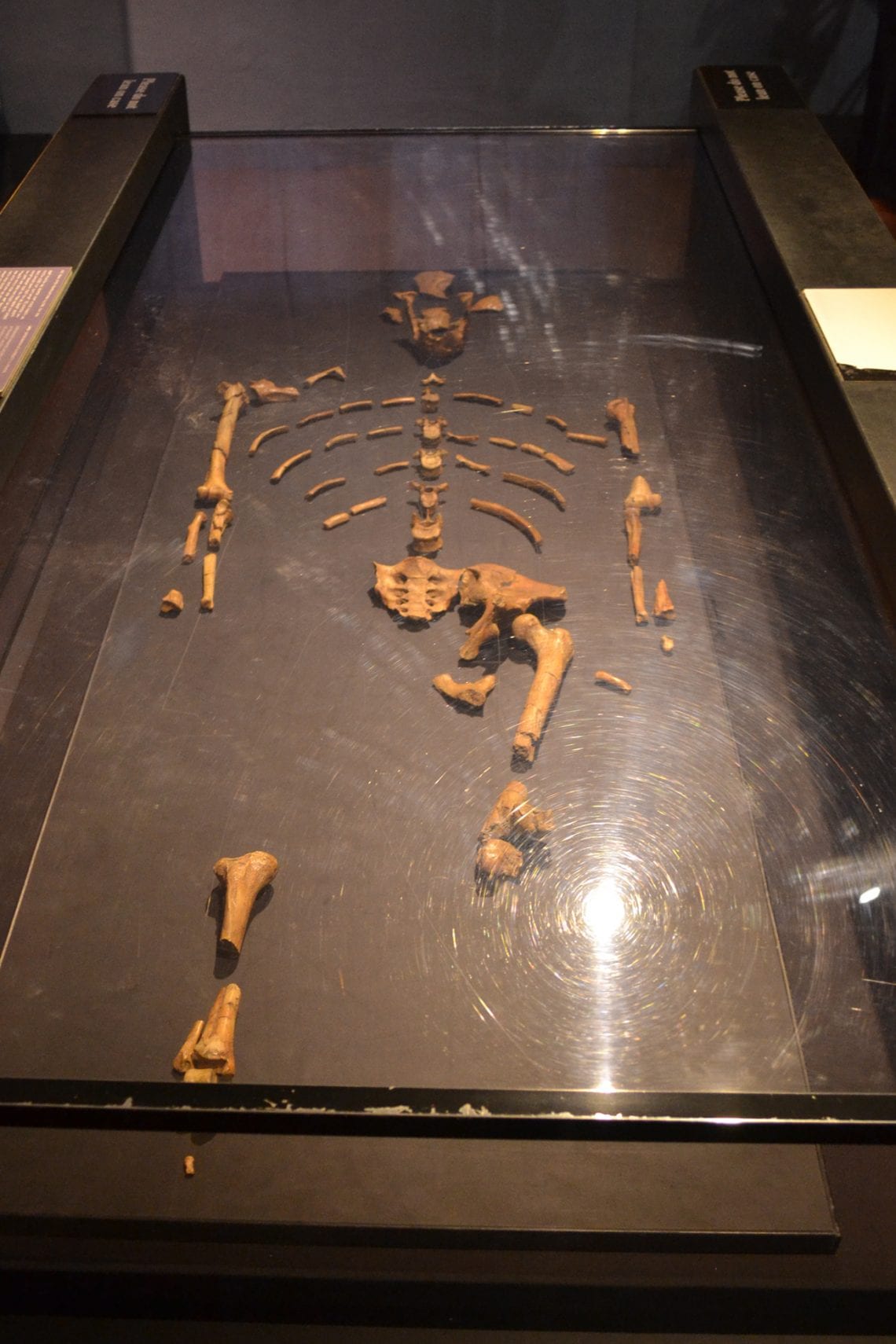
Above: Learning about Ethiopia’s rich history | Lucy is 3.2 million years old and named after the Beatles song
The obligatory stop in the afternoon at the ‘Lucy’ Restaurant recharges our energy and we go for an afternoon coffee in Tomaca; a popular coffee shop said to serve the best coffee in town. As I popped by the previous day by myself, I take the time to stroll around the streets of Addis before we make a whistle stop tour of the Mercato. Feeling more comfortable within a crowd, it’s a good opportunity to take the pictures that I missed out on the previous day. Whilst I feel safe, it is very real that we are the only Westerns, once again, in this jungle of traders.
The comfortable air conditioned mini-van takes us to the Holy Trinity Church. Again, built as a memorial to oppression but this time the Italian occupation of the 1930s. The church itself is surrounded by well maintained gardens and a forest that masquerades the building itself. A path leading to the church is the only glimpse of the dust stain Orthodox Church. The area is busy, children running around playing and women sitting and chatting. Our guide takes us inside and we are asked to take off our shoes. The temperature is cool inside but the stunning glass stained windows, illuminated by the sun coming through, warms the air. We are told the biblical story of each stained glass window and follow around to the front of the church. Here we are met with the tombs of Emperor Hallie Selaslie and his wife. Grand in size but not in nature, side by side in life and death, Hallie Sellasie and his wife lay in two dark brown marble tombs. Here there is no grand homage to the former leader but there is the odd local who arrives to pay there respects.

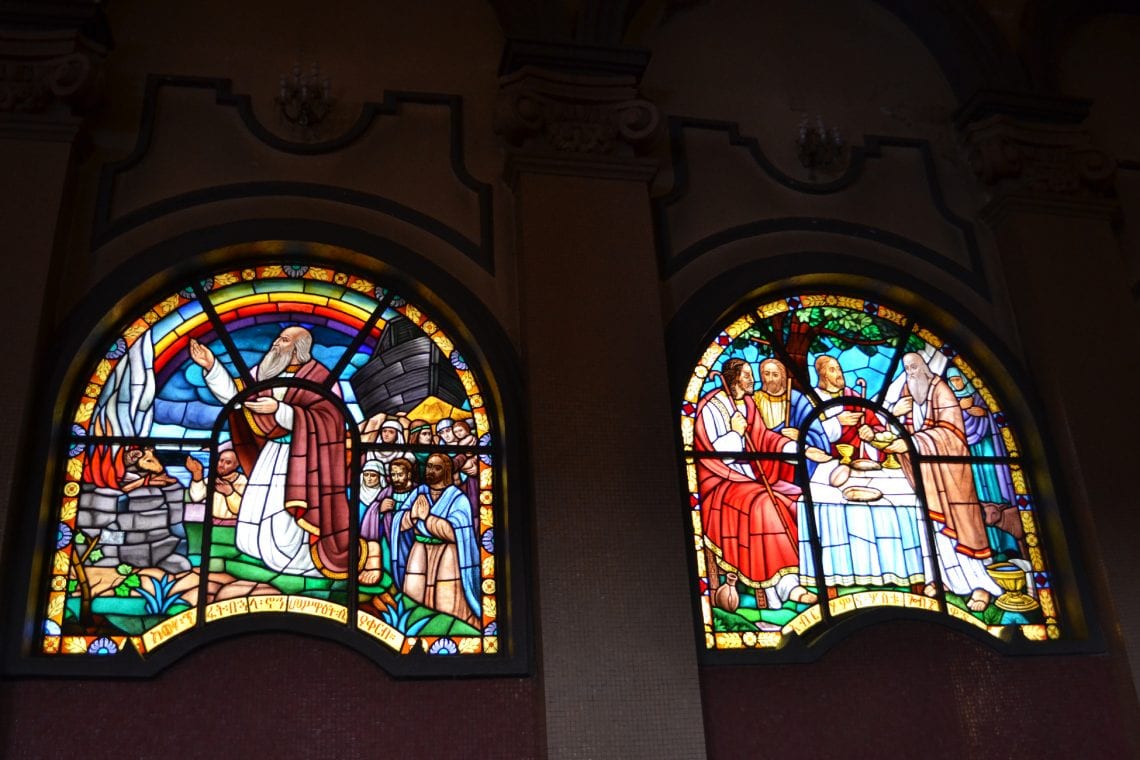
Above: The Sun beaming through the impressive stained glass at the Holly Trinity Cathedral
The drive to Dire Dawa
Day three
Day three and it’s an early morning walk up at 5am. The group appears at breakfast in drips to gorge on the morning pancakes they have set up just for our group. Much of the day will consist of a 10 hour drive to Dire Dawa as we start our journey East towards Somaliland but the journey will offer great views of the Ethiopian countryside; if I can stay awake. If I had ever forgotten I was in Africa, I was quickly reminded. The little sleep I could get was intermittently interrupted with jolts as the mini bus made its way through the pot hole laden road. I took this as a benefit and rather than sleep through the views, I propped by head up, plugged in Toto’s ‘Africa’ and gazed out onto the green pastures of Africa.
As we made our way further East, the lush green colours around Addis were gone, making way to a more dull green bush. Mountains still filled the landscape but the reality of living here was clearing harsher. We have a welcomed break stopping at a roadside village for a bite to eat and a mid morning beer. Turning away for a second, and Jin, one of the Chinese travelers on our group appeared with ‘Khat’ a local amphetamine like stimulant which is said to cause excitement, loss of appetite and euphoria. Knowing the beer situation was set to worsen and disappear all together once we hit Somaliland, we gave it a try. A bitter taste filled our mouths and with the locals around us laughing and helping themselves to Jin’s supply we spat it out. How could anyone chew this for long enough to feel the effects was beyond us but scanning the locals, it was easily identifiable with who was ‘off their rocket’ on ‘khat’.
We eventually arrived in Dire Dawa about 4pm and spent the afternoon lying by the pool. The cloudy water which clearly had no chlorine in didn’t seem to bother the locals and so I took a dip to cool off.

Above: The long drive to East to Dire Dawa – 11hours!
Hanging out with Hyenas
Day four
A morning tour of Dire Dawa proves fruitless as the railway station and British Cemetery we are here to see are both closed. Nonetheless, it is a chance to soak up the atmosphere and vibe of the city and we can enjoy the railway station and cemetery from the outside. Through the gates of the cemetery you can just about see the graves of three British RAF soldiers who died in the war fighting the Italians occupation during WW2. Sadly, despite memorial date just passing, we are told there is no memorial service held here as those we experience in the Western World. The grounds remain immaculately attended to as a mark of respect and not for the first time on this tour I fall silent deep in my thoughts. Upon leaving the cemetery, I spot a man wearing nothing more than bin liners rooming the streets. Whilst appearing comical, is a stark realisation that despite Ethiopia’s economy booming an impressive 10% average a year, parts of the population are still in dire need of aid.
In the afternoon we take a 1 hour drive to UNESCO listed Harar, The final stop before we enter Somaliland and the 4th holiest site for Islam. The short journey is welcomed and our trip is only interrupted by a street protest that is making its way down the road. Naturally, we are in a volatile area and I can help but sink in my chair, hoping is not the end of our journey. Our guide, Abdul reassures us that it’s a peaceful protest against the government and in a show of support our driver persists in sounding the horn and waving. Satisfied with the support, the group armed with their protest banners passed the minibus without incident.
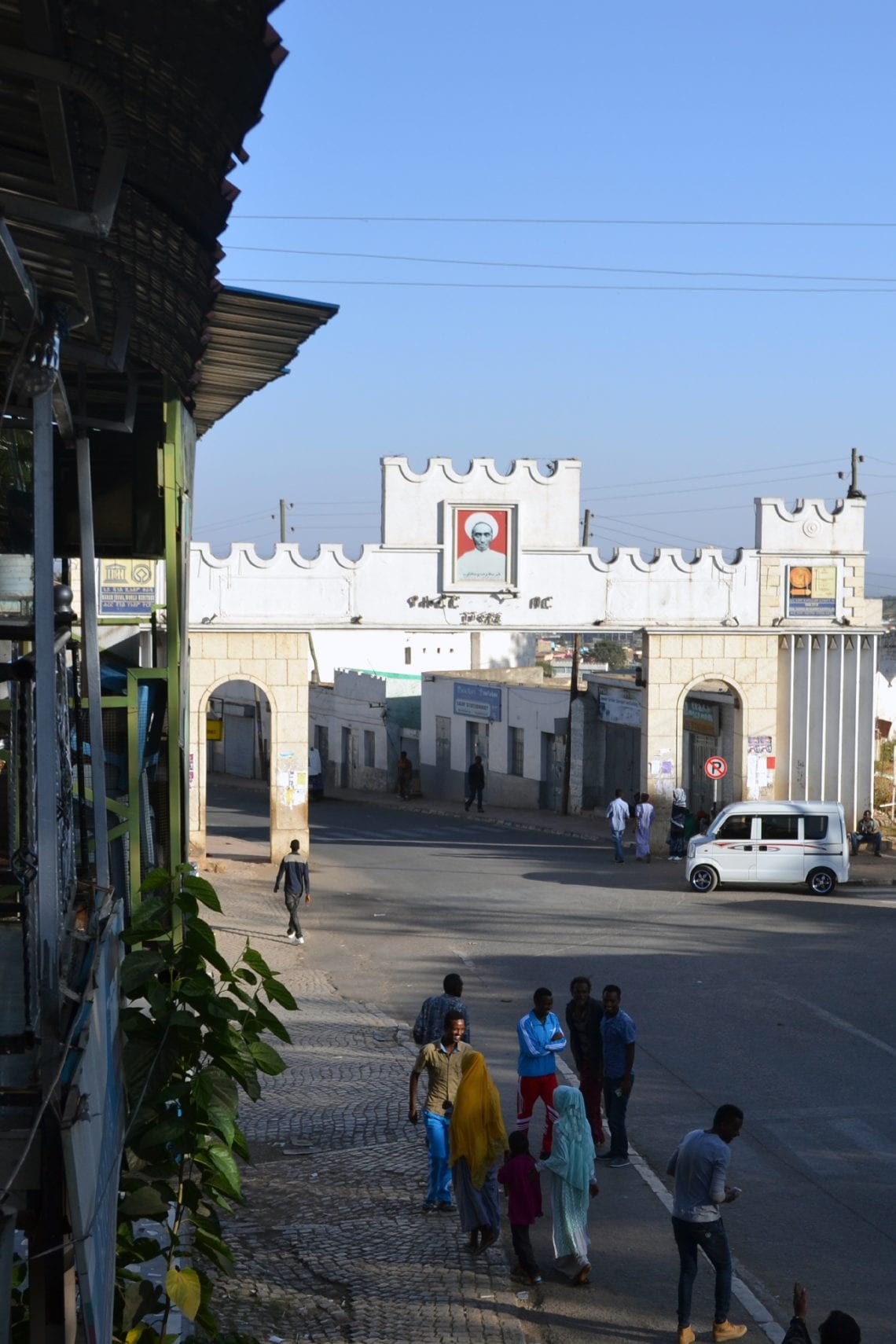
Above: The British cemetery from the first World War | The city of Harar – the 4th holiest site in Islam
That evening was reserved for a definite highlight of the trip. We were to visit the Hyena man of Harar who in the third family generation has been feeding the wild Hyenas every night at 7pm.We arrived just as darkness set in. Along a bumpy dirt track we pulled in to the outskirts of Harar. Out of the darkness, our headlights beamed on a man who sat on a stool with a basket next to him. We clambered out of the minibus with excitement and from a distance of 10metres stood and stared. Suddenly one by one, Hyenas appeared. Shy at first but as the local started yelling out slogans from Lion King, clearly naming them for the tourists after known characters, they approached for the nightly feast of raw meat. Before long, I had counted twenty of these wild animals encircling him, all salivating at the prospect of meat. After a brief familiarization with himself, the local invited the onlookers to come and feed the hyenas themselves. It was my turn. Shaking with fear but conscious that there were a dozen onlookers, I sat next to the man who forced a stick in my hand and poached some meat on the end of it. Before I could even blink, I felt a tug on the stick and the meat was gone. I nodded at the man in approval and gestured for more meat to be added to the stick. A second hyena approached slowly and with a snap of its jaw, the meat was gone again. My heart racing with adrenaline it was incredible to see these creatures so close I could physically smell them. I scampered off, relieved in my safe getaway and let someone else have a turn.
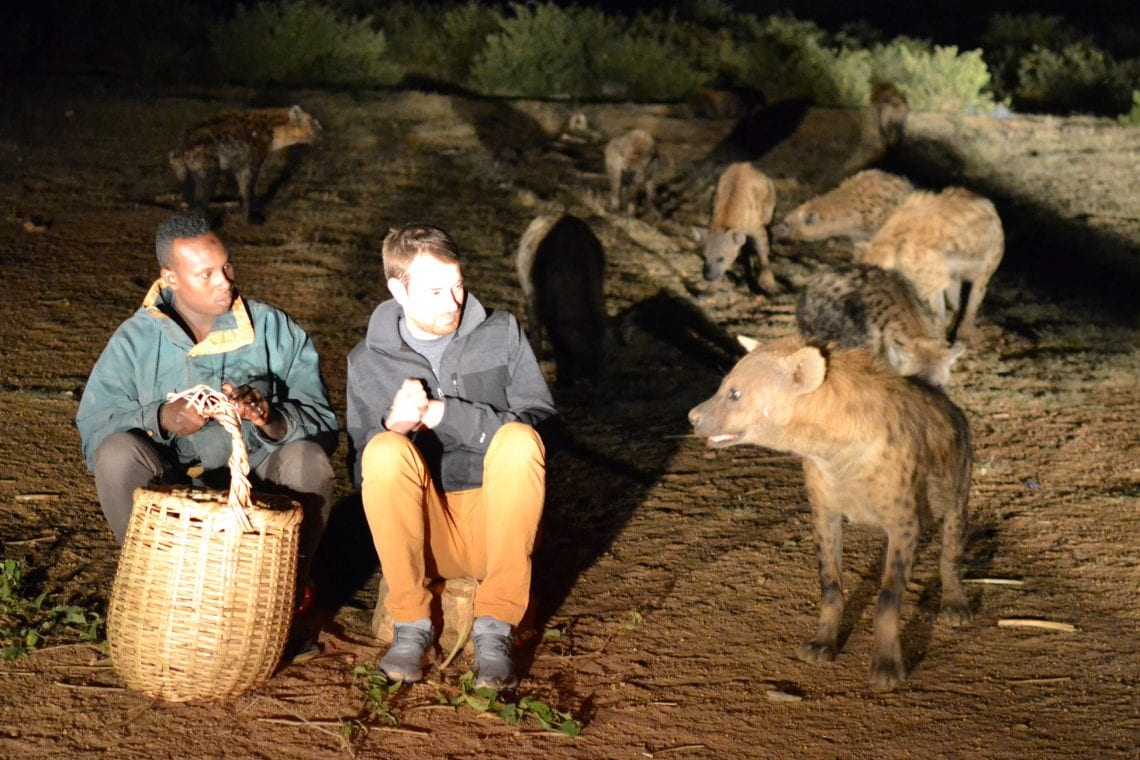
Above: This man has been feeding wild Hyenas for years, each night they return expecting a feast
Walk among the rail track
Day five
Halfway into our expedition and with the disappointment in missing the Railway Station the previous day still in my mind, the group is given an option to go back one hour to Dire Dawa to the railway station or to visit the livestock market near Harar. As I knew we would be visiting a similar market in Hargeisa, me and a few others opt for the journey back to Dire Dawa to explore the semi abandoned station whilst the other half of the group headed to the livestock market. James, our tour leader opts for staying in the hotel as a bout of food poisoning has immobilised him.
I can only describe the railway station in a contradiction of adjectives. The station whilst still operating a train service, has the impression it has been long abandoned and forgot. Rusty train carriages litter the overgrown grass and goats roam in and out of the carriages. There no passengers loitering around and its dead quiet. We wander around the perimeter and through the train houses, spotting relics from Ethiopia’s industrial past, admiring the original notices and even clocks, though long not working, still on display. We stumble across the French style revolving table and our driver tells us it is still in working order. It’s a perfect picture opportunity on something that I relate back to my days watching Thomas the Tank Engine. We walk to the main train station building and clamber aboard a derelict train. The windows are smashed, the insides are gutted, graffiti painted on the walls and what appears like bullet holes riddle the side of the carriage. I ask our driver who is having a conversation with one of the employees about the train. I’m astonished to the answer I received. I had been expecting a story of perhaps the civil war or occupation under the French/Italian but instead I was told the train is in working order – “Yes, the train leaves tomorrow morning with passengers to the Djibouti border”. How anyone could ever endure 8 hour in those conditions I will never know but it had my mind racing that it’s something I wanted to experience.
Back in Harar we had an afternoon tour of the city. Our guide Abdul, who had been with us since we left Addis, was clearly in his element. The residents of Harar were smiling and greeting him, shaking his hand and there was a clearly a lot of respect towards him. He dominated the streets with a sense of authority and whilst it would be considered rude to enter someone’s house where a wedding was taking place, no-one had clearly told Abdul and we were taken into the courtyard to watch the celebrations. A pattern was forming; this was my second Lupine Travel Tour and my second wedding crashing.
Amongst the windy streets of the inner city, we are taken to a stunning French Renaissance house. Whoever lives here was clearly a wealthy individual I thought to myself but my questions were soon answered, Arthur Rimbaud. The famous French poet had settled in Harar in the 1880’s whilst establishing himself as an independent merchant. The house now serves as a museum and the walls are covered in photo’s of Harar’s earlier years, a wonderful insight into the development of the city.
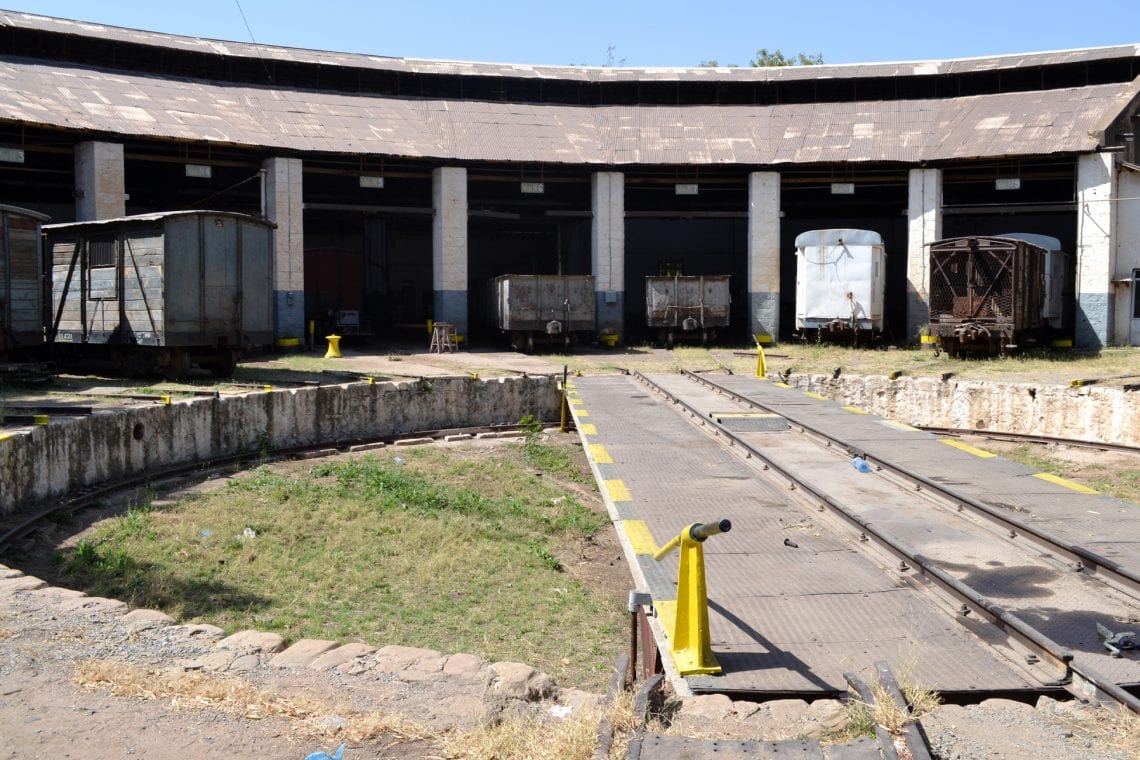
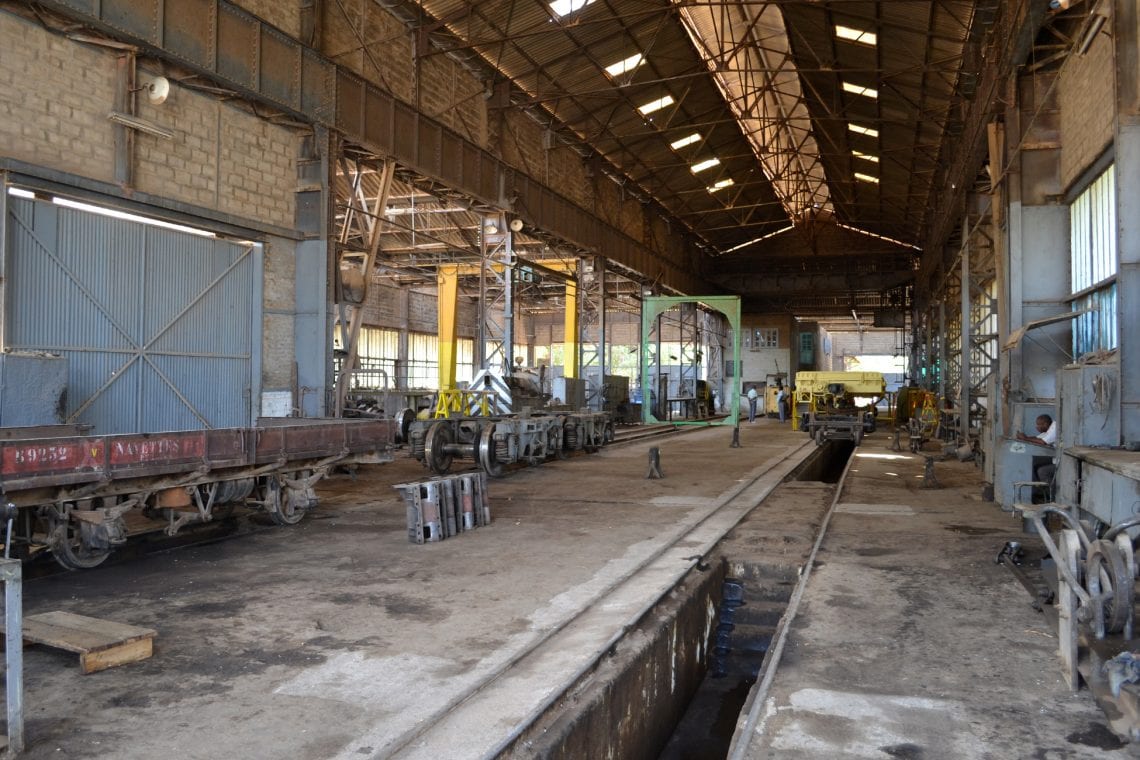
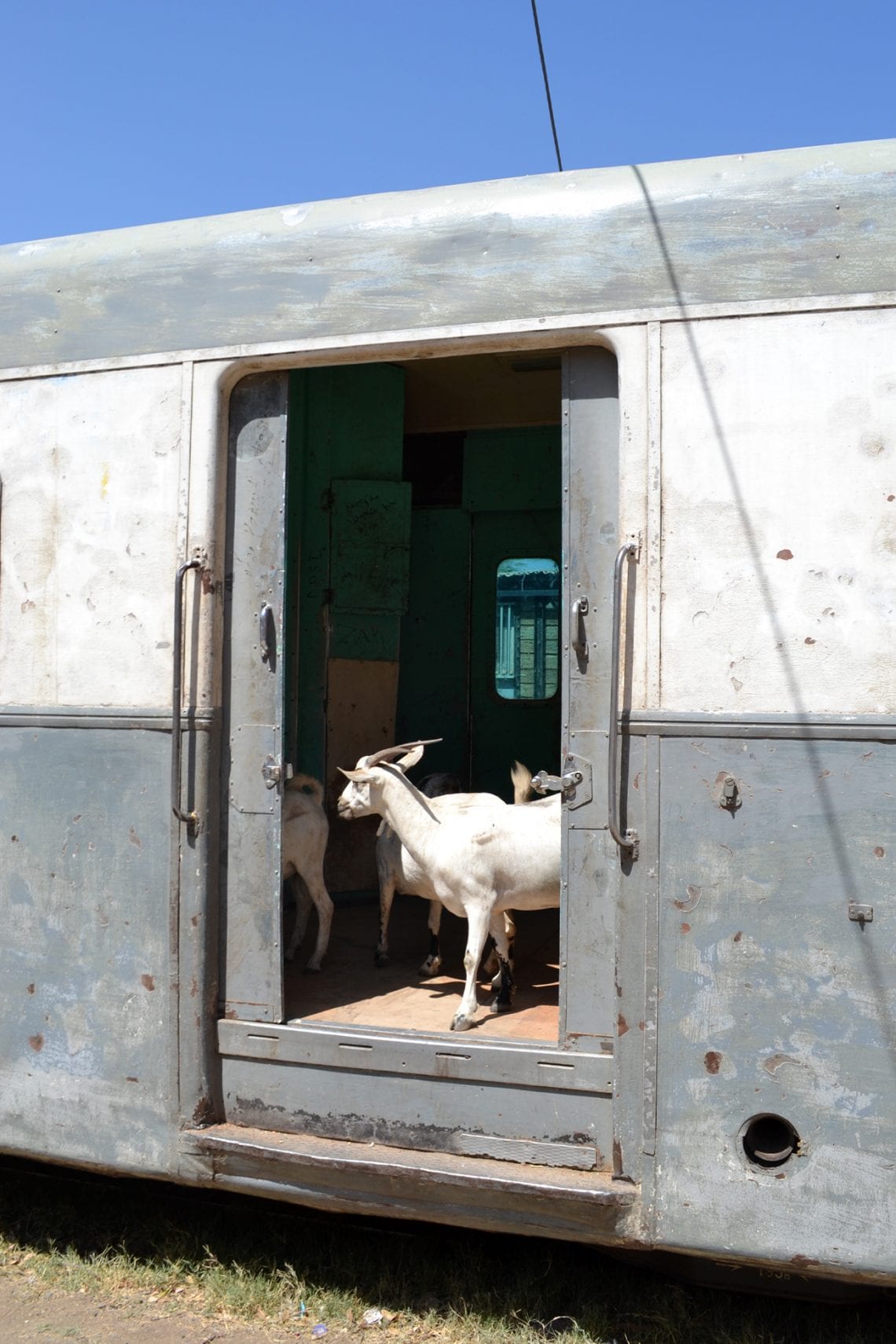
Above: Trains, trains and more trains at Dire Dawa | You can still actully get a train to Djibouti from here
Arriving in Somaliland
Day six
Today we would enter Somaliland; the business end of the trip. The moment every one of us had been waiting for was here and whilst I describe myself as a confident off the beat backpacker, even I was becoming nervous for what lay ahead. Without international recognition, Somaliland is simply bunched together with Somalia; arguably the most dangerous place in the World and I was about to enter it. Serious doubt filled my mind and anxiety kicked in. I was throwing the pro’s and con’s around in my head until I decided over thinking it was what was causing my anxiety and next thing I knew I loaded up the mini bus with my backpack and off we set on the three hour drive to the border. The landscape had become increasing barren. The lush green mountains of Ethiopian were long gone and now replaced with dead or dying vegetation. The planes had become so flat you could see miles into the distance. The occasional dust tornado broke up the scene and if it wasn’t for the scattered refugee camps we saw, the place would be deserted for miles.
The road to the border was empty and whilst we seemed to be the only traffic making our way towards Somaliland, the border was chaotic. Merchants and traders had established a trading post in no-mans land between the two nations and money was exchanging hands. The burst of activity was too much to absorb so we made our way into the Ethiopian Customs and Immigration office. Here in a small office sat an officer with a ledger in front of him. We sat in the room and one by one he called us up to get our exit stamp and entered us into his log book. Within half an hour, the dozen of us had been processed and passing a large bin full of what I presumed to be confiscated IDs and several officials chewing khat, we were set on our way to cross the bridge that would take us to the Somaliland side. We jumped over the unmanned rope that was symbolically there to mark an international border and embarked on a 5 minute walk to where a 4×4 and minibus were waiting. We jumped into our transport and drove a mile down the road to the Somaliland Customs and Immigration were we got out. The chaos had died down and the office seemed isolated. We were greeted by several officials, as always, chewing ‘khat’ and rounded up into a small cramp office for processing. The rooms were simple but served its purpose. One by one we were summoned to a chair and through a glass barrier, handed over our passports. If I was expecting an interrogation, I would be disappointed. A smile for a photograph later, and the next one was being called. Even after this brief encounter, Somaliland started toppling preconceptions. It was the Ethiopian Immigration office still using a pen and paper, and it was the Somalilander’s using computers and digital webcams. Still, that didn’t stop them from missing the fact that ‘Republic’ was mis-pelt on my official Somaliland visa issued from London., either that, or they didn’t care.
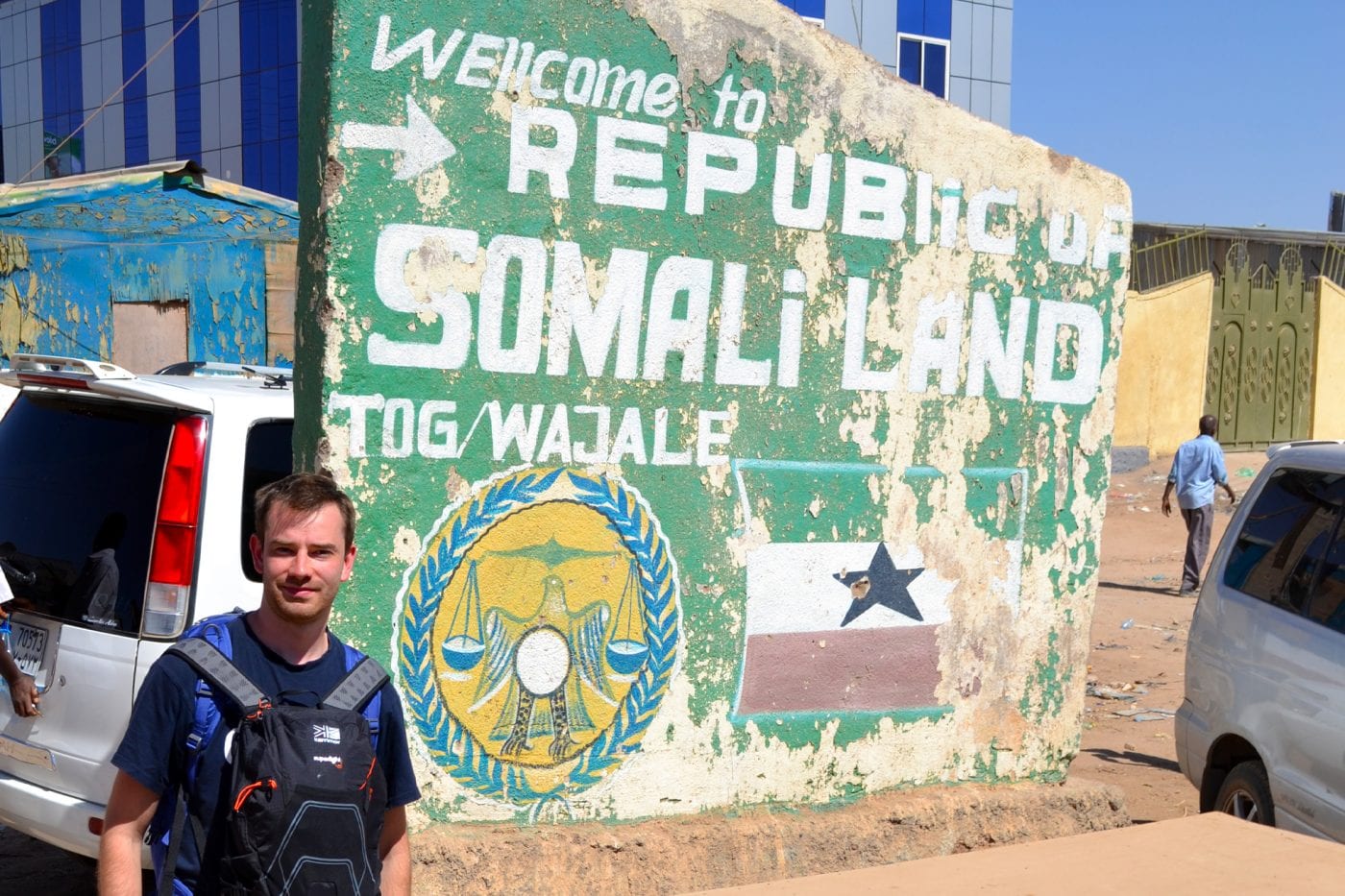
Above: Dan entering Somaliland, a country that doesn’t exist
It is a requirement that every Western is accompanied by a security guard if travelling outside Hargeisa and it was outside the immigration office I first noticed the soldier that was accompanying our trip. A tall slim man in his 40’s was drowning in his khaki uniform. Sporting his bere and AK47, I was unsure whether this made me more at ease or more on edge.
The drive to Hargeisa took a further 1.5hours and the scenery reminiscent of the drive leading up to the border and apart from the unscheduled flat tyre, time flew past. Upon arrival, the city was chaotic . We checked into the Oriental Hotel, a survivor from colonial times with a charming café courtyard but didn’t waste too much time hanging around. The obligatory Facebook update and message back home to confirm everyone was safe and we went for our first real taste of Hargeisa. The capital city was chaotic with people bustling past each other and wandering amongst the traffic. Vendors lined the streets trying to flog their goods and get a glimpse of us Westerners parading down their city. Stopping occasionally to look what was on offer, we drew large crowds. The large type of crowds that all guide books and the FCO tells you to avoid and so we frequently moved on. The locals were friendly and inquisitive as to our purpose in visiting Hargeisa and happy to hear when we told them we were tourists. A sense of pride shone from the smiles that tourism was reaching this part of the World and they welcomed us with open arms. Having overcome the initial nervousness of walking through Hargeisa, a couple of the group and I broke off from the rest of the group and continue exploring the markets areas.
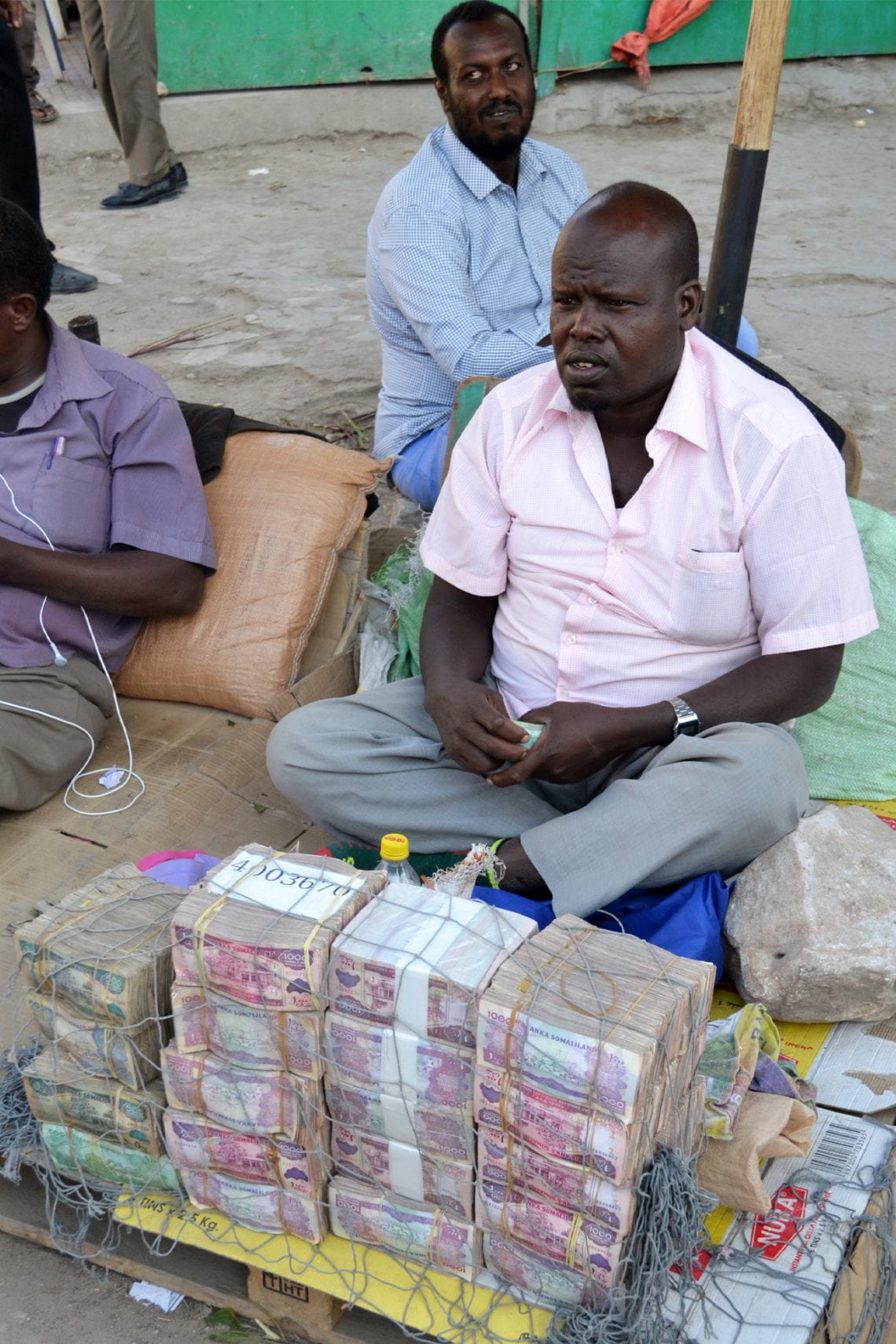
Above: Money changers with wads of cash in Hargeisa wait for customers on the street | Mig monument in Hargeisa commemorating Somaliland’s breakaway from the rest of Somalia during the 1980s
Discovering ancient cave paintings
Day seven
Today would include one of the trips highlights. After a 1.5hour transfer along pot hole ridden road, we arrived at a turn, off piste to the Las Geel Cave Paintings. These cave paintings lay undiscovered by Westerns until 2002 when French archeologists were sent to the area to search for rock shelters and caves. What they found instead was some of the best preserved cave paintings dating back anywhere between 9000 and 3000BC. A short walk to the rocky outcrop and past a small museum, there were several shelters all magnificently decorated in images of cows and herders. The colours, despite being so old were still so vibrant, protected by the arid environment and sheltered from the sun; it was easy to imagine the area bustling with herders all those years ago. Sadly, with the discovery of these paintings, there were also indications of modern day vandalism where scratch marks covered some of these remarkable drawings. An act that has now prompted the appointment of several guards and guides.
After a two hour drive we arrived at the colonial coastal town of Berbera. Our hotel was located on the beach front in a secure compound and after having our bags checked and being subjected to a pat down, we checked into our comfortable and more importantly, air conditioned rooms. Keen to wash off the dust of the day we headed to the beach. Jumping into the warm waters, it felt surreal to be swimming in perhaps the world’s most dangerous waters where modern day pirates had been causing havoc in international trading routes in the not too distant past. Climbing out onto the deserted beach, it was a prime time to enjoy a non alcoholic beer as the sun set over the horizon.

Above: Laas Geel’s rock art is estimated to date to somewhere between 9,000 and 3,000 years BC
Time to hit the beach
Day eight
We woke up to the last full day in Somaliland to be the first Lupine tour to be granted a permit to sail around the wrecks in the port of Berbera and go snorkeling out at sea. The owner of the hotel drove us in his 4×4 a short off piste distance, along the coastline to a landing dock past the industrial port. The waters were calm and we gingerly climbed aboard one of two boats and set sail amongst the trawlers and vast cargo ships. The waters were clear and it was easy to spot crabs. After 20minutes or so, we had reached the port. It was eerily quiet and the port looked abandoned. We sailed past, towards the wrecks when we were greeted by shouting from a landing dock. An imposing man in army uniform was walking down the dock clearly disgruntled by our presence and judging by the tone of his voice this interaction as not going to go well. The skipper of our boat cut the engines and with the officer exchanged some dialect in Arabic. It was pretty easy to understand the army officer was not going to permit us to get any closer to the wrecks despite having the paperwork in order. The engines rumbled to a start and the skipper moved us closer at a slow and steady pace to the wrecks. He was clearly disregarding any instruction to move away from the area so we could see up close the ship graveyard. I noticed that the soldier we had left behind had not been armed and so thought to myself that any consequences of not following his instructions would be limited as he could see we posed no threat to the port. This thought was short lived as out of the blue, a grey, unmarked speed boat with several men abroad came hurtling towards us. Not being able to identify the men in any official manner, a moment of adrenaline appeared. Was the guard on the dock warning us of potential dangers and had we just fallen foul to some criminals? The adrenaline intensified as one of them men on the speedboat uncovered a mounted machine gun and pointed it towards our boat. We were now either going to find ourselves in a Somaliland jail, or someone’s prisoner but rather than strike fear into me, it actually put me at ease. After all, what criminals have sophisticated mounted machine guns on their boats and we drew a conclusion that this was the Somaliland navy. Official or unofficial we did not know and it did not matter. The message was crystal clear, leave this area immediately. To ensure we did, it escorted us away and once happy we would not return, it left us and headed back towards the port. Later when back on land, we found out they wanted $20 per person to allow us to swim in the area.
We take in lunch in the centre of town at a local restaurant serving fresh fish and overlooking the ship graveyard. So fresh that once they sell out of their daily catch, the restaurant closes until the next day. Catering to a group of 11, we were certainly going to be there last customers today before we explored Berbera. Berbera had once served as the capital to the British Somaliland Protectorate until the 1940s when it was replaced by Hargeisa. Today, it serves as Somaliland’s official port. Much of the colonial old town has crumbled away but our tour of the city still highlights a few standing ruminants. Standing in the main square, James and I have a non- alcoholic beer just as the British would have done decades ago and people watch whilst the rest of the group wander around. The city is calm without the hustle and bustle of Hargeisa and radiates a charm of a once vibrant and complicated past.
Continuing through Berbera, Somaliland’s complex history is further intensified by a drive through Little Moscow; a district on the outskirts of Berbera that used to house workers in Soviet style apartment blocks during the Soviet Union’s operations of the airbase and port in the 80s. Much of the buildings are still standing and compared to the colonial building, I considered them being in habitable condition. A family wave us on our way from there balcony as we drive back to our hotel.
We spend the afternoon at leisure back on the beach on the Gulf of Aden, attracting the attention of some children. Together with their willingness to pose of pictures and several females enjoying the beach without there hijabs, Berbera continues the stereotype of seaside cities being more easy going. There is a sense that with the heavy investment from the United Arab Emirates and China, a sense of liberalism is creeping in and it is a matter of time before the first Western Style Resort opens on the coast of Aden.
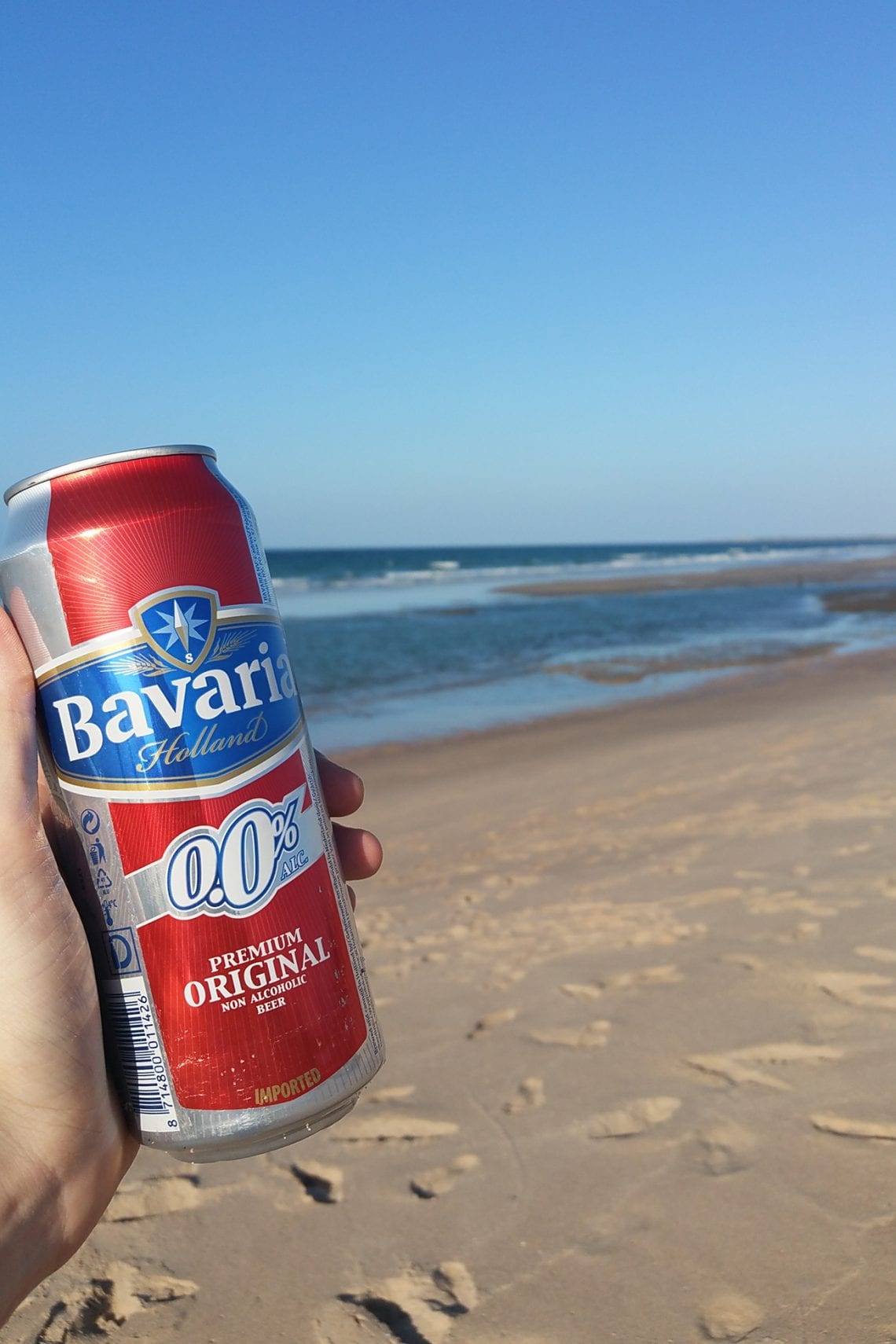
Above: Cruising around the Gulf of Aden | A well earned non-alcoholic beer
The end and return home
Day nine
It was the end of our tour in Somaliland and the day started when I interrupted a debate between one of our group and an Emirati contractor. The gent was in Berbera working on a multimillion dollar investment in the city airport and port and found it appropriate to share his negative views of Britain over breakfast with a Brit. Upon retaliating, the contractor, walked away and his friend apologised for his behavior. Soon after, we finished our omelet’s and jumped in our minibus for our long drive back from Berbera, past the Las Geel caves we had visited earlier in the week and to our final destination in Hargeisa. The trip back had been planned precisely so we wouldn’t need to hang around the city but go straight to the airport to catch our flights to Addis. Before that, Somaliland had one more treat for us and we stopped at the side of the road after spotting a large obstacle in the road. We got out and what seemed like a giant rock was in fact the biggest tortoise I had ever seen. Spooked by the sudden attention, it retreated into its shell and set up shop in the middle of the road. Rather than leave it to its unpredictable fate, James and Ben lifted it and carried it to where it was headed before we interrupted it.
The airport was secure with several lines of security checks and a small shop selling refreshments. A vendor had set up shop selling souvenir t-shirts and postcards for an extortionate amount of dollars; but, he clearly hadn’t realised that you need stamps and a postbox to send the greetings and I was left taking a blank postcard back home with me.
The flight back to Addis presented us with our first opportunity to have a beer in several days and we congratulated ourselves on an educational experience. Somaliland had welcomed us with open arms and I felt that we had offered a glimpse into his potential future as a more ‘open’ country. Most importantly, I felt that everyone in the group agreed it deserves its opportunity as a fully functioning and sovereign state. Somalilander’s are proud of the achievements they have worked towards and visiting it showed us the determination and obstacles the local people are overcoming in order to become a recognised country. With most of the Western World turning a blind eye, Lupine Travel are certainly bringing Somaliland to the forefront of breaking the stigma.
WHERE TO STAY
If you are booking a tour your agent will organise your accommodation but always check.
USEFUL LINKS
For the most part you will need to travel via Ethiopia. Due to the situation it’s best to opt for an escorted tour and arrange your travel plans in advance. We recommend Lupine Travel – www.lupinetravel.co.uk




